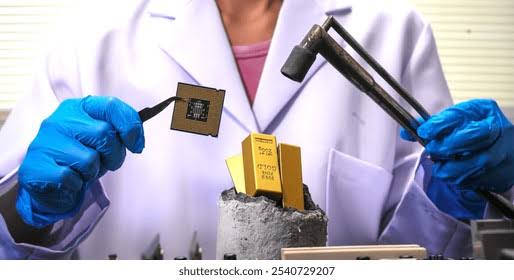Researchers develop microwave-based method to boost recovery of critical metals from e-waste

By Faridat Salifu
Researchers at West Virginia University have developed a pioneering microwave-powered process that could significantly improve the recovery of tantalum and a high-value, heat-resistant metal from discarded electronics. The process, which avoids the use of toxic chemicals and reduces energy consumption, marks a major advancement in the global effort to sustainably manage electronic waste and secure critical raw materials.
Led by a team in the Department of Mechanical, Materials & Aerospace Engineering, the research introduces a method that uses industrial-grade microwaves to extract tantalum from capacitors embedded in electronic devices such as mobile phones, laptops, medical instruments, and defense-grade technology. The team’s findings were recently published in Scientific Reports, a peer-reviewed journal.
Tantalum is a critical material for modern electronics, prized for its ability to store and discharge energy quickly without degrading under high temperatures. Its capacitors are widely used in space-constrained, high-performance environments, including medical implants and satellites. Yet despite its value—tantalum was priced at around $170 per kilogram in 2024—recycling rates remain extremely low.
“Globally, we are discarding enormous amounts of tantalum every year simply because it’s not economically or technically viable to recover it through existing methods,” said the project’s lead investigator. “Our process changes that equation by offering a simpler, cleaner, and much more efficient path to recovery.”
from waste to resource: the microwave breakthrough
The method developed by the team involves several stages. First, discarded tantalum capacitors are mechanically shredded into a fine powder. This powder is then mixed with a carbon-based absorbent material, which is key to the microwave process. Unlike water or metals, carbon absorbs microwave energy very efficiently, allowing for intense, localized heating. When exposed to microwave radiation, the carbon initiates a carbothermal reduction reaction, converting the tantalum compounds into tantalum carbide.
“Tantalum carbide is a valuable, industrial-grade material that we can then further refine into pure tantalum metal,” the researcher explained. “Our tests have shown that the process yields tantalum at a purity level of over 97%.”
This method bypasses the traditional route of acid leaching or smelting, which typically involves hazardous chemicals and consumes large amounts of energy. As a result, the new process produces significantly fewer toxic byproducts and greenhouse gas emissions.
tackling the global e-waste crisis
The innovation comes amid growing concern over the environmental and geopolitical consequences of poorly managed electronic waste. According to the Global E-waste Monitor, the world generated more than 62 million metric tons of e-waste in 2022, with most of it either ending up in landfills or being exported to low-income countries where informal recycling practices—including open burning and acid baths—pose serious health and environmental risks.
Despite being a major consumer of electronics, the United States recycles only a fraction of its e-waste, and is heavily dependent on imports for many of the materials needed to manufacture high-tech equipment. Tantalum, for instance, is largely imported from countries like China, Rwanda, and the Democratic Republic of Congo. This dependence creates supply chain vulnerabilities, especially for industries tied to national security.
scaling up for strategic independence
To accelerate the path from lab to industry, the West Virginia team is now running pilot-scale trials involving more complex e-waste streams, such as printed circuit boards from smartphones and end-of-life servers from data centers. These pilot programs aim to test the microwave technology’s scalability and cost-effectiveness in real-world recycling environments.
Initial funding for the project came from the Defense Advanced Research Projects Agency (DARPA) under its Recycling at the Point of Disposal (RPOD) initiative. The program seeks to enhance U.S. capabilities for recovering strategic materials domestically, particularly in times of geopolitical instability.
“The DARPA grant reflects the strategic importance of this work,” the researcher said. “If we can recover materials like tantalum in-country, efficiently and safely, it reduces our reliance on unstable supply chains and improves our resilience in the face of global disruptions.”
economic and environmental gains
The team believes their method could change the economic calculus of e-waste recycling. Traditional recyclers often skip over tantalum and other rare materials because the recovery costs outweigh potential profits. But the new microwave-based process, with its lower operational costs and minimal waste footprint, could make recovery financially attractive.
“Once recyclers realize that they can recover metals worth hundreds of dollars per kilogram using a relatively low-cost, environmentally friendly process, we anticipate significant uptake,” said the team’s co-author. “This could transform how we handle electronics at the end of their life cycle.”
Beyond tantalum, the researchers are exploring whether similar techniques can be applied to extract other critical materials such as neodymium, cobalt, and lithium from spent electronics and batteries. If successful, this could pave the way for a new generation of high-efficiency, low-emission recycling technologies.
laying the groundwork for a circular economy
The project aligns with broader global efforts to transition from a linear “take-make-dispose” model to a circular economy, where valuable materials are continually reused, reducing the need for virgin mining and limiting environmental degradation.
Experts say such innovations are vital not only for environmental sustainability but also for securing the raw materials necessary to support green technologies like electric vehicles, wind turbines, and solar panels.
“Our electronic waste is not just trash it’s an untapped urban mine,” the researcher said. “With the right technologies, we can reclaim those resources and build a more sustainable, resilient, and self-reliant future.”
The research team is now seeking industry partners and public-private collaborations to further refine the technology and build the infrastructure needed to commercialize the process on a national scale.
